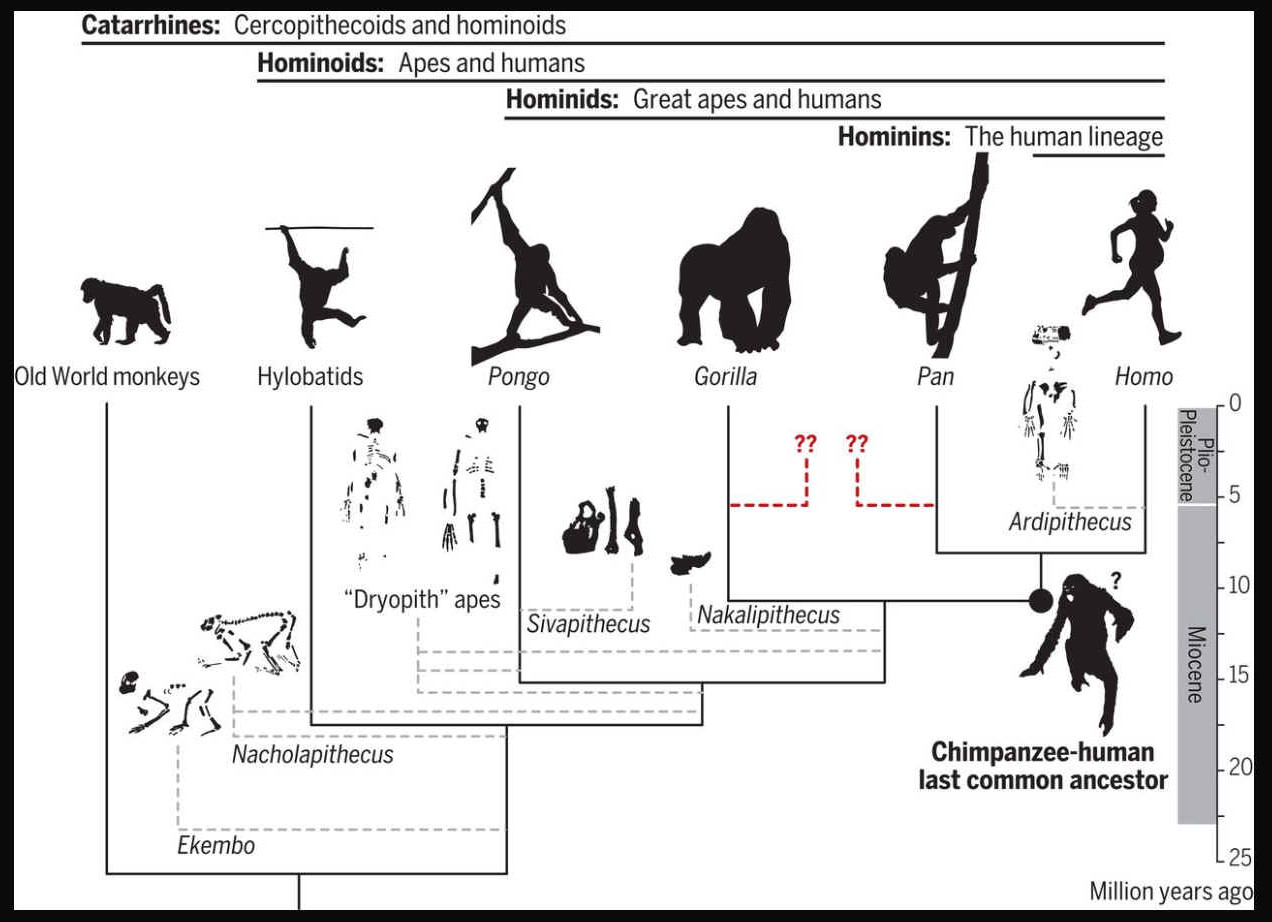
How
we got here, and where we are going. Ever since the writings of Darwin and Huxley,
humans place in nature relative to apes (nonhuman hominoids) and the geographic origins of the human lineage (hominins) have been heavily debated. Humans diverged from apes [specifically, the chimpanzee lineage (Pan)] at some point between ~9.3 million and ~6.5 million years ago (Ma), and habitual bipedalism evolved early in hominins (accompanied by enhanced manipulation and, later on, cognition). To understand the selective pressures surrounding hominin origins, it is necessary to reconstruct the morphology, behavior, and environment of the Pan-Homo last common ancestor (LCA). Top-down approaches have relied on living apes (especially chimpanzees) to reconstruct hominin origins. However, bottom-up perspectives from the fossil record suggest that modern hominoids represent a decimated and biased sample of a larger ancient radiation and present alternative possibilities for the morphology and geography of the Pan-Homo LCA. Reconciling these two views remains at the core of the human origins problem.
Homo erectus (/ˌhoʊmoʊ əˈrɛktəs/; meaning "upright man") is an extinct species of archaic human from the Pleistocene, with its earliest occurrence about 2 million years ago. Several human species, such as H. heidelbergensis and H. antecessor with the former generally considered to have been the ancestor to Neanderthals, Denisovans, and modern humans appear to have evolved from H. erectus. Its specimens are among the first recognizable members of the genus Homo. H. erectus was the first human ancestor to spread throughout Eurasia, with a continental range extending from the Iberian Peninsula to Java. Asian populations of H. erectus may be ancestral to H. floresiensis and possibly to H. luzonensis. The last known population of H. erectus is H. e. soloensis from Java, around 117,000108,000 years ago.
H. erectus had a more modern gait and body proportions, and was the first human species to have exhibited a flat face, prominent nose, and possibly sparse body hair coverage. Though brain size certainly exceeds that of ancestor species, capacity varied widely depending on the population. In earlier populations, brain development seems to cease early in childhood, suggesting that offspring were largely self-sufficient at birth, thus limiting cognitive development through life. H. erectus was an apex predator; sites generally show consumption of medium to large animals, such as bovines or elephants, and suggest the development of predatory behaviour and coordinated hunting. H. erectus is associated with the Acheulean stone tool industry, and is postulated to have been the earliest human ancestor capable of using fire, hunting and gathering in coordinated groups, caring for injured or sick group members, and possibly seafaring and art (though examples of art are controversial, and are otherwise rudimentary and few and far between).
H. erectus males and females may have been roughly the same size as each other (i.e. exhibited reduced sexual dimorphism), which could indicate monogamy in line with general trends exhibited in primates. Size, nonetheless, ranged widely from 146185 cm (4 ft 9 in 6 ft 1 in) in height and 4068 kg (88150 lb) in weight. It is unclear if H. erectus was anatomically capable of speech, though it is postulated they communicated using some proto-language.
It has been proposed that H. erectus evolved from H. habilis about 2 Mya, though this has been called into question because they coexisted for at least a half a million years. Alternatively, a group of H. habilis may have been reproductively isolated, and only this group developed into H. erectus (cladogenesis).
Because the earliest remains of H. erectus are found in both Africa and East Asia (in China as early as 2.1 Mya, in South Africa 2.04 Mya), it is debated where H. erectus evolved. A 2011 study suggested that it was H. habilis who reached West Asia from Africa, that early H. erectus developed there, and that early H. erectus would then have dispersed from West Asia to East Asia (Peking Man), Southeast Asia (Java Man), back to Africa (Homo ergaster), and to Europe (Tautavel Man), eventually evolving into modern humans in Africa. Others have suggested that H. erectus/H. ergaster developed in Africa, where it eventually evolved into modern humans.
H. erectus had reached Sangiran, Java, by 1.8 Mya, and a second and distinct wave of H. erectus had colonized Zhoukoudian, China, about 780 kya. Early teeth from Sangiran are bigger and more similar to those of basal (ancestral) Western H. erectus and H. habilis than to those of the derived Zhoukoudian H. erectus. However, later Sangiran teeth seem to reduce in size, which could indicate a secondary colonization event of Java by the Zhoukoudian or some closely related population.
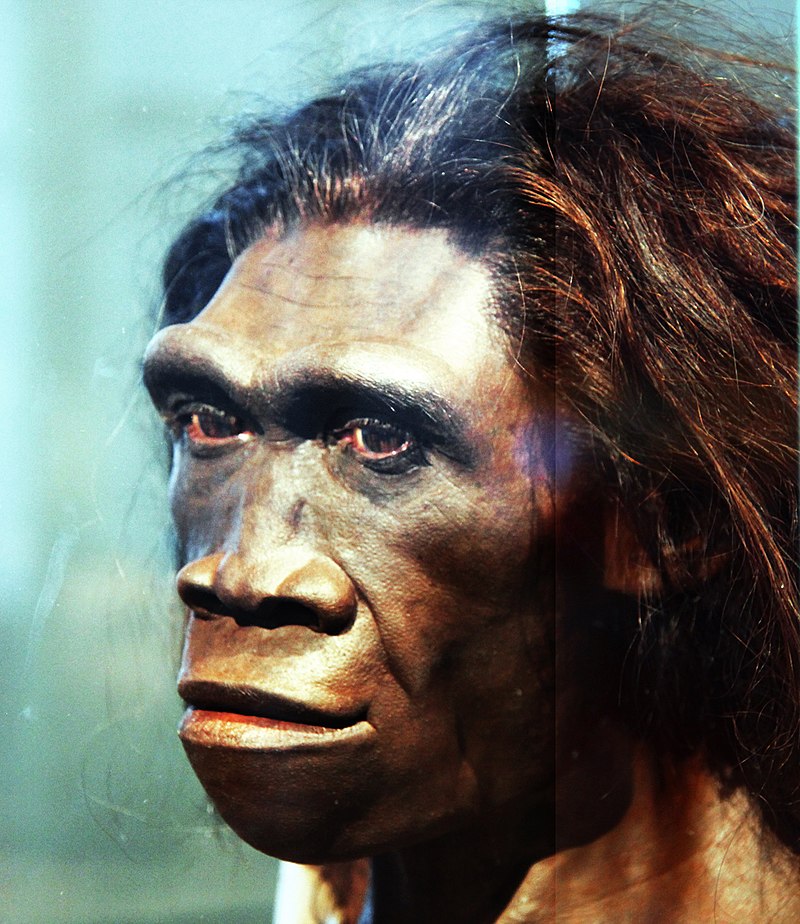
HOMO
ERECTUS: artists impression of a female of the species, with flattened
nose and arched brows. Not intellectually well developed, but with many
evolutionary advantages, mainly walking upright and using tools.
TOOLS AND FIRE
H. erectus is credited with inventing the Acheulean stone tool industry, succeeding the Oldowan industry, and were the first to make lithic flakes bigger than 10 cm (3.9 in), and hand axes (which includes bifacial tools with only 2 sides, such as picks, knives, and cleavers). Though larger and heavier, these hand axes had sharper, chiseled edges. They were likely multi-purpose tools, used in variety of activities such as cutting meat,
wood, or edible plants. In 1979, American paleontologist Thomas Wynn stated that Acheulean technology required operational intelligence (foresight and planning), being markedly more complex than Oldowan technology which included lithics of
un-standardized shape, cross-sections, and symmetry. Based on this, he concluded that there is not a significant disparity in intelligence between H. erectus and modern humans and that, for the last 300,000 years, increasing intelligence has not been a major influencer of cultural evolution. However, a 1 year old H. erectus specimen shows that this species lacked an extended childhood required for greater brain development, indicating lower cognitive capabilities. A few sites, likely due to occupation over several generations, features hand axes en masse, such as at Melka Kunture, Ethiopia; Olorgesailie, Kenya; Isimila, Tanzania; and Kalambo Falls, Zambia.
The earliest record of Acheulean technology comes from West Turkana, Kenya 1.76 Mya. Oldowan lithics are also known from the site, and the two seemed to coexist for some time. The earliest records of Acheulean technology outside of Africa date to no older than 1 Mya, indicating it only became widespread after some secondary H. erectus dispersal from Africa.
On Java, H. erectus produced tools from shells at Sangiran and Trinil. Spherical stones, measuring 612 cm (2.44.7 in) in diameter, are frequently found in African and Chinese Lower Paleolithic sites, and were potentially used as bolas; if correct, this would indicate string and cordage technology.
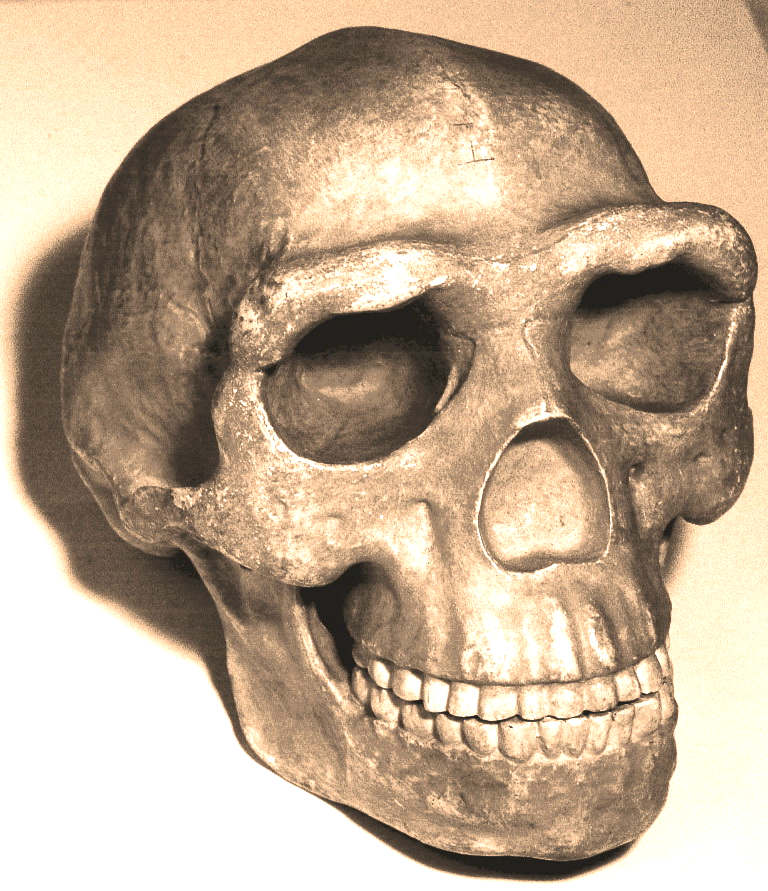
Skull
of Peking Man
FIRE
H. erectus is credited as the first human ancestor to have used fire, though the timing of this invention is debated mainly because campfires very rarely and very poorly preserve over long periods of time, let alone thousands or millions of years. The earliest claimed
fire sites are in Kenya, FxJj20 at Koobi Fora and GnJi 1/6E in the Chemoigut Formation, as far back as 1.5 Mya, and in South Africa, Wonderwerk Cave, 1.7 Mya. The first firekeepers are thought to have simply transported to caves and maintained naturally occurring fires for extended periods of time or only sporadically when the opportunity arose. Maintaining fires would require firekeepers to have knowledge on slow-burning materials such as dung. Fire becomes markedly more abundant in the wider archaeological record after 400,000300,000 years ago, which can be explained as some advancement in fire management techniques took place at this time or human ancestors only opportunistically used fire until this time. It is possible that firestarting was invented and lost and reinvented multiple times and independently by different communities rather than being invented in one place and spreading throughout the world. The earliest evidence of hearths comes from Gesher Benot Ya'aqov, Israel, over 700,000 years ago, where fire is recorded in multiple layers in an area close to water, both uncharacteristic of natural fires.
Artificial lighting may have led to increased waking hours - modern humans have about a 16-hour waking period, whereas other apes are generally awake from only sunup to
sundown - and these additional hours were probably used for socializing. Because of this, fire usage is probably also linked to the origin of language. Artificial lighting may have also made sleeping on the ground instead of the trees possible by keeping terrestrial predators at bay.
Migration into the frigid climate of Ice Age Europe may have only been possible because of fire, but evidence of fire usage in Europe until about 400300,000 years ago is notably absent. If these early European H. erectus did not have fire, it is largely unclear how they stayed warm, avoided predators, and prepared animal fat and meat for consumption. There was also a lower likelihood of naturally occurring fires due to lightning being less common in areas further north. It is possible that they only knew how to maintain fires in certain settings in the landscapes and prepared food some distance away from home, meaning evidence of fire and evidence of hominin activity are spaced far apart. Alternatively, H. erectus may have only pushed farther north during warmer interglacial
periods - thus not requiring fire, food storage, or clothing technology and their dispersal patterns indicate they generally stayed in warmer lower-to-middle latitudes. It is debated if the H. e. pekinensis inhabitants of Zhoukoudian, Northern China, were capable of controlling fires as early as 770 kya to stay warm in what may have been a relatively cold climate.
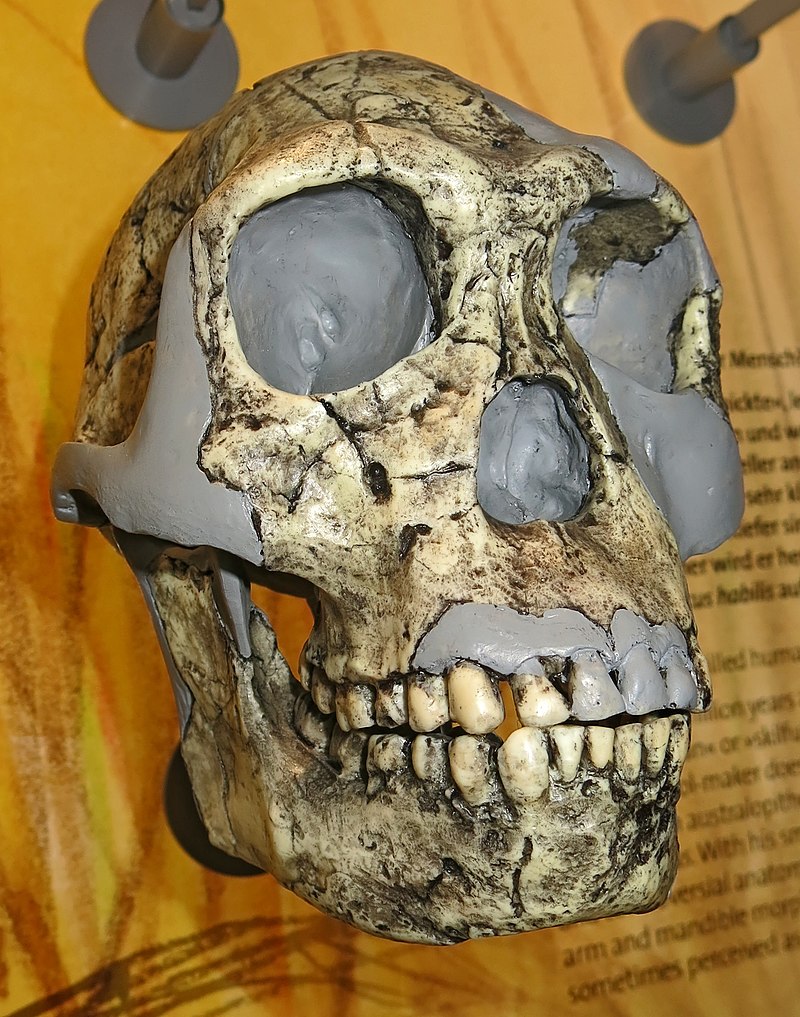
Reconstructed
skull of Homo Neanderthalis, brows less pronounced.
KANIS
REX - HOMO SAPIENS SUPERIOR
Man
took millions of years to develop from the apes, into
Homo Sapiens Sapiens, king of the primates until John
Storm was accidentally injected with a CRISPR
virus developed by Brazilian scientists working for the secret society; NeuWelt
Rittertum. The amateur anthropologist was later forced to
undo damaging alterations to his DNA, in so doing creating a new
species, physically and mentally superior to Homo S. Sapiens; named Homo
Sapiens Superior, or Kanis
Rex. These modifications were sufficient in scope to place him well
and truly in a new class. Progressing from Homo Sapiens Sapiens, to
become the king of men genetically.
The
modifications, only possible with the CyberCore Genetica super
computer, combined with the BioCore
brain implant - and Hal's
AI,
were not just to his mental and muscular capabilities, but also to his
physical frame; his skeleton. Which is now stronger and lighter. All of
which in the natural world, would have taken a million or so years to
have achieved, assuming there would have been a clear natural selection advantage.
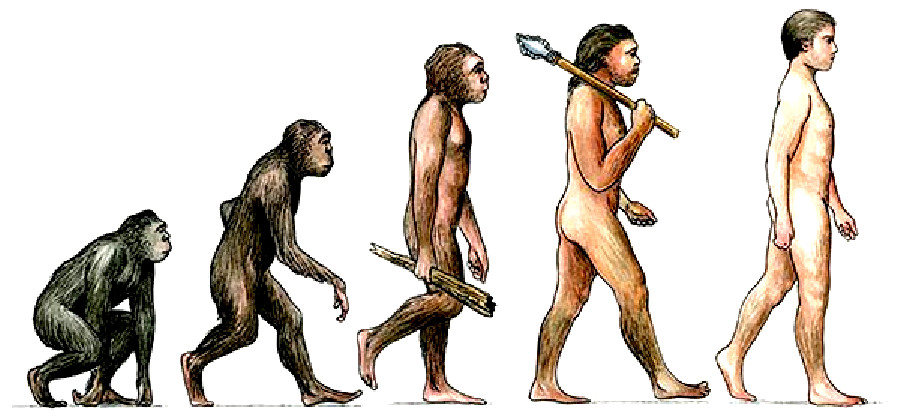
Sahelanthropus
Ardipithecus
Australopithecus
A. anamensis
A. afarensis
A. bahrelghazali
A. africanus
A. garhi
A. sediba
Kenyanthropus
Paranthropus robustus
Homo habilis
H. floresiensis
H. erectus
H. e. georgicus
H. cepranensis
H. antecessor
H. heidelbergensis
H. naledi
H. helmei
Homo neanderthalensis
Homo sapiens
H. s. idaltu
Homo Sapiens Sapiens
Homo
Sapiens Superior (Kanis
Rex)

EVOLUTION
Humans are apes (superfamily Hominoidea). The lineage of apes that eventually gave rise to humans first split from gibbons (family Hylobatidae) and orangutans (genus Pongo), then gorillas (genus
Gorilla), and finally, chimpanzees and bonobos (genus Pan). The last split, between the human and
chimpanzee - bonobo lineages, took place around 8 - 4 million years ago, in the late Miocene epoch. During this split, chromosome 2 was formed from the joining of two other chromosomes, leaving humans with only 23 pairs of chromosomes, compared to 24 for the other apes. Following their split with chimpanzees and bonobos, the hominins diversified into many species and at least two distinct genera. All but one of these
lineages - representing the genus Homo and its sole extant species Homo
sapiens - are now extinct.
The genus Homo evolved from Australopithecus. Though fossils from the transition are scarce, the earliest members of Homo share several key traits with Australopithecus. The earliest record of Homo is the 2.8 million-year-old specimen LD 350-1 from Ethiopia, and the earliest named species are Homo habilis and Homo rudolfensis which evolved by 2.3 million years ago. H. erectus (the African variant is sometimes called H. ergaster) evolved 2 million years ago and was the first archaic human species to leave Africa and disperse across Eurasia. H. erectus also was the first to evolve a characteristically human body plan. Homo sapiens emerged in Africa around 300,000 years ago from a species commonly designated as either H. heidelbergensis or H. rhodesiensis, the descendants of H. erectus that remained in Africa. H. sapiens migrated out of the continent, gradually replacing or interbreeding with local populations of archaic humans.
Humans began exhibiting behavioral modernity about 160,000-70,000 years ago, and possibly earlier.
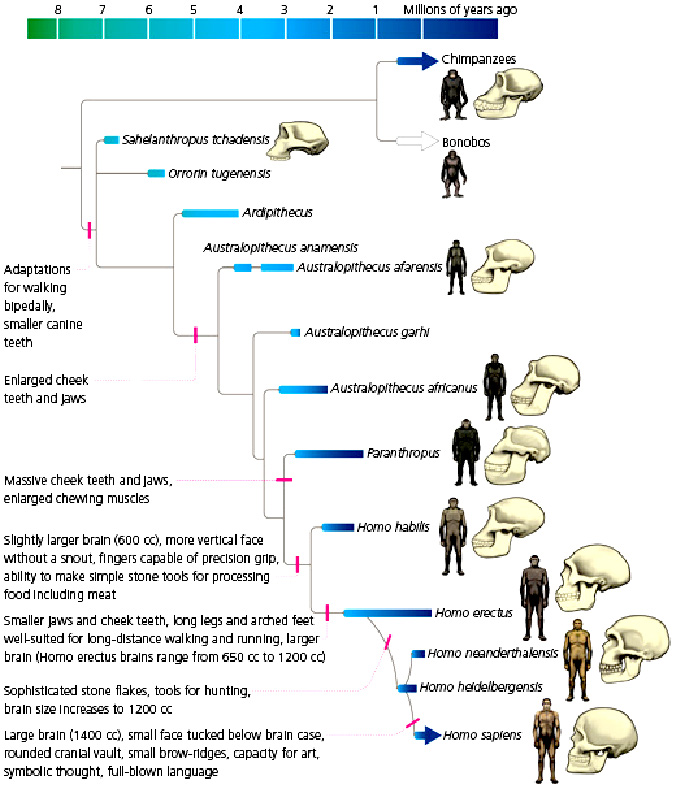
The "out of Africa" migration took place in at least two waves, the first around 130,000 to 100,000 years ago, the second (Southern Dispersal) around 70,000 to 50,000 years ago. H. sapiens proceeded to colonize all the continents and larger islands, arriving in Eurasia 125,000 years ago, Australia around 65,000 years ago, the Americas around 15,000 years ago, and remote islands such as Hawaii, Easter Island, Madagascar, and New Zealand between the years 300 and 1280 CE.
Human evolution was not a simple linear or branched progression but involved interbreeding between related species.
Genomic research has shown that hybridization between substantially diverged lineages was common in human evolution.
DNA evidence suggests that several genes of Neanderthal origin are present among all non sub-Saharan African populations, and Neanderthals and other hominins, such as Denisovans, may have contributed up to 6% of their genome to present-day non sub-Saharan African humans.
Human evolution is characterized by a number of morphological, developmental, physiological, and behavioral changes that have taken place since the split between the last common ancestor of humans and
chimpanzees. The most significant of these adaptations are obligate bipedalism, increased brain size and decreased sexual dimorphism (neoteny). The relationship between all these changes is the subject of ongoing debate.

The
Cup of Christ is the Holy Grail, that has never been found, in all
searches through the ages.







